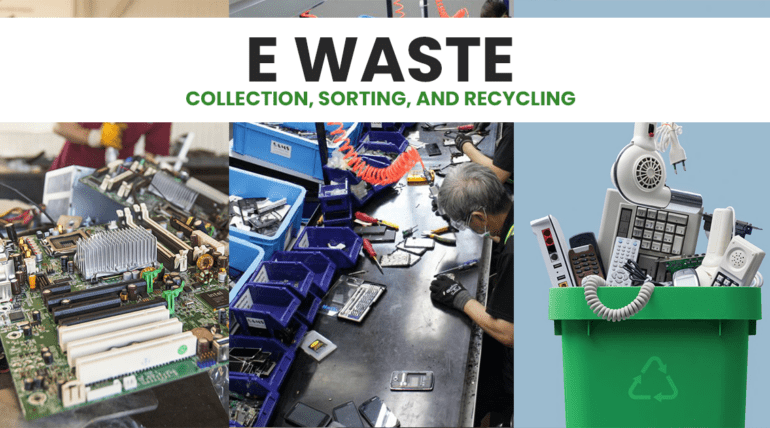E Waste Collection, Sorting, and Recycling
The term “e-waste” refers to electrical waste. Recycling old electrical and electronic equipment is important for efficient e-waste management. When an electrical device stops functioning or reaches the end of its service life, it turns into electronic waste. Any discarded electrical or electronic equipment can be used for material recovery, recycling, reuse, or resale. Since technology is evolving so quickly, a lot of electronics are being manufactured, which leads to the creation of e-waste. One can contact e-waste management professionals for hassle-free e waste collection from home. These professionals know the proper treatment, disposal, buying, and reselling of these types of trash.
What is an e waste collection center?
An e waste collection center is an organization that collects, categorizes, processes, and dismantles electronic waste for recycling, refining, redesigning, and reselling purposes. These collection hubs comply with the E-Waste (Management) Rules, 2016, and E-Waste (Management) Amendment Rules, 2017, to carry out electronic waste disposal and e-waste recycling activities. They have their own collection mechanism to channel and dispose of waste.
If businesses or homeowners want to hand over their old electronic products, they can reach out to an e waste collection center for environmentally conscious disposal. Once the request for service is placed, these centers schedule a pickup for E waste collection from home and commercial centers. They offer a pickup receipt with each pickup.
Components of E-waste That Can be Recycled
- Plastic– Plastic materials can be collected and recycled. The recycled plastic elements can next be used to make products like plastic vineyard stakes and sleepers. Furthermore, you can get equipment holders, insulators, plastic trays, fence posts, and much more.
- Metal– Metals can also be recycled and recovered to create newer steel and metal products.
- Glass– CRTs (Cathode Ray Tubes) in televisions and computer monitors can be used to remove the glass. This e-waste collection extract can then be used to create newer screens.
- Mercury– Mercury can be removed from devices before sending them to recycling centers using specialized technology. Metric tools, dental amalgam, and fluorescent lights can be made from this.
- Circuit Boards– Tin, gold, silver, copper, palladium, and other important metals are smelted and recovered by certified E waste collection companies.
- Hard Disk– Aluminum ingots can be extracted from hard drives by shredding and processing them. These are very helpful for cars.
- Toner and Ink Cartridges– These toner and ink cartridges are collected for recycling by recyclers in different manufacturing sectors that remanufacture them. Then, they employ the recovered plastic and metal as raw materials for other goods.
- Batteries– Old batteries have cadmium, steel, nickel, and cobalt back for use in new batteries. They are helpful in the fabrication of stainless steel.
Aside from the items listed, there are an endless number of other things. And no, there isn’t a one-size-fits-all strategy for e waste recycling. There is, however, a standard procedure to follow. So how exactly is e-waste recycled? Let’s get started.
Process of Electronic Waste Disposal
E waste recycling can be complicated since these are mechanical devices composed of various combinations of glass, metals, and polymers. Below is a general summary of the electronic waste disposal process, which can vary based on the materials being recycled and the technology used.
Collection and Transportation
Collection and transport are two of the primary stages of recycling e-waste. Disposal companies either make trips for E waste collection from home or office or set up collection bins or booths for discarding old electronics in specific locations. Next, they transport the collected e-waste to processing plants and facilities.
Separation, Sorting and shredding
After collection and delivery to recycling facilities, items in the e-waste are cleaned and sorted into clean commodities for making new products. The basis of e-waste recycling is effective material separation. The shredding of the e-waste supply makes it easier to sort and remove the plastics from the metals and internal hardware. To prepare for further Sorting, e-waste is shredded into portions as small as 100mm.
A strong overhanging magnet pulls iron and steel from the trash stream on the conveyor. The sorted steel parts are then ready to be sold as recycled steel. Further mechanical processing collects aluminum, copper, and circuit boards from the remaining material stream. After that, glass and plastic are separated using a water separation technique. The extracted materials’ quality is enhanced by visual inspection and manual Sorting. Aluminum, copper, and circuit board streams are separated and collected for sale as recycled raw materials.
The technique employs cutting-edge separation technology. In order to further clean the stream, the final stage in the separation procedure detects and separates any remaining metal pieces from the plastics.
Getting Things Ready to Sell as Recycled Materials
Following the phases of shredding, Sorting, and separation, the materials are made ready for sale as useful materials for the production of new hardware or other electronics.
Final Takeaway
Electronic waste disposal is a major global concern for a variety of reasons. It has a significant impact on both life on earth in general and our surrounding conditions as humans. E waste recycling ensures huge economic benefits for individuals, communities, and even entire nations.
The number of opportunities opened up by e-waste collection has already attracted a lot of attention. Entrepreneurs in underdeveloped countries are using e-recycling to advance environmental goals and generate a cash flow. Even though the stages are labor-intensive, they are simple to follow. Of course, you can gain back from recycling e-waste and contribute to saving the environment as well.



One thought on “E Waste Collection, Sorting, and Recycling”